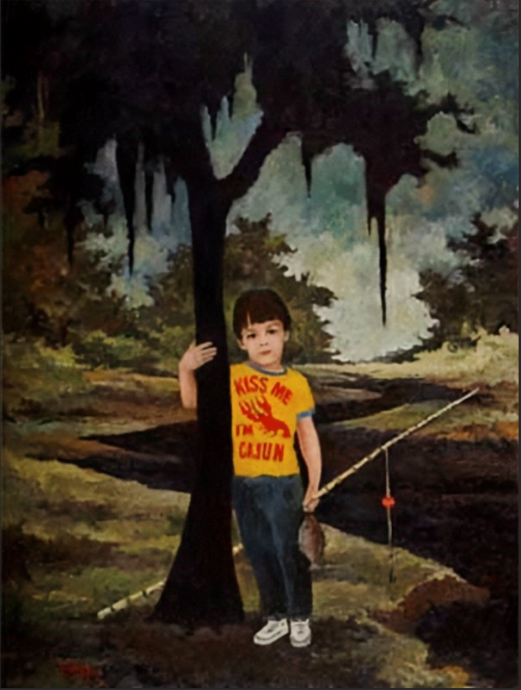\ 'lan-ˌyap , lan-'yap \ : a small gift given to a customer by a merchant at the time of a purchase; broadly : something given or obtained gratuitously or by way of good measure

Shrimp Boat, Eddie Valdez
How Much Longer?
As a kid growing up in South Louisiana, my family would often go trawling for shrimp and other seafood. We would trawl the nearby bayous and Lake Pontchartrain, and hopefully return with ice chests full of shrimp, fish or crabs.
For those of you who have not trawled, it can be a long and boring process as you drag the net slowly behind your boat, waiting for it to fill with your catch. It was kind of like waiting for Christmas in that it seemed to take forever and you did not know what you would get. It might be a mix of shrimp, fish, crabs, or maybe an old Dixie Beer can.
The question my brother and I would ask (multiple times, I am sure), was "How much longer?" Dad would just say, "Not yet." How did he know it was time? I asked him this recently and he said, "You can just feel it." He could feel when enough time had passed, and the net was full by how the boat felt. In other words, he could sense when we had enough, so that we could stop and pull in the net.
In a similar way, the word "enough" factors into financial planning many times. It is central to the fundamental questions of, "Will I ever have enough," "Will it always be enough," and "How much is enough?"
How Much Is Enough?
Retirement is perhaps the single greatest topic of discussion in financial planning. Nearly everyone looks forward to a day when the normal pressures of life will fade away, and they will have an opportunity to slow down and enjoy the fruits of their labor. When I discuss retirement with Clients, they usually ask some version of these three questions:
Interestingly, you cannot answer the first two questions until you fully answer the third. But answering the third question requires more reflection than calculation. Why?
For as much as people talk about retirement, I find that many people do not spend enough time thinking about retirement. Few have spent serious time contemplating what they will do, where they will live, and what a normal daily routine will look like. What most people imagine is a time of endless golf or daily poolside naps. Some imagine spending time with grandchildren or tending to their garden. But what do you do with the other 10-12 hours in the day or the other 5 days of the week?
This is where some priceless reflection will pay huge dividends. As you plan for retirement, you have to ask yourself:
These reflective questions will help you understand what you can expect in retirement, and also determine what you will do with your time. Once that is settled (or at least nearly so), then you will be able to refine your financial needs.
The word that I use to bring focus to this entire process is "purpose." We have to determine what provides purpose in our daily activities, personal interests, and the needs of others. Then we can begin to understand what you will need financially to support this new lifestyle. In other words, now we can answer the question, "How much is enough?"
So, give this some thought. Consider what it will take to determine your purpose, and then schedule yourself for a conversation. I want to hear your thoughts, plans and financial needs. Together, we can build a plan to get you ready for a fully purposeful retirement.
Laissez les bons temps rouler
Mary's Recipe Corner
Shrimp Creole
We found this recipe in Bill's Mom's recipe box after she passed and thought you might enjoy it. Although I am a vegetarian, it seems like the best recipe for this edition of Lagniappe.
Make a quick shrimp stock by bringing to boil in two quarts water all the shrimp shells and heads that you have peeled. Add green onion tops. Bring to boil and then simmer until ready to use.
Melt butter with the oil over low fire for a minute or two and then add the flour. Stir slowly over a low fire until the flour is brown. Add the onions, green pepper, and celery. Cook until the vegetables are soft. Add the chili powder, tomatoes, tomato paste, and shrimp stock. Cover and simmer over low heat for about 20 minutes.
After 20 minutes, add shrimp, salt, black pepper, cayenne, green onions, and parsley. Stir well and cook just until the shrimp turn pink. Do not over cook. Remove from heat and let stand for ten minutes before serving. Serve over rice.
Creole or Cajun?
For those that wonder what differentiates Creole from Cajun dishes, there are a few notable differences:
Whether you have creole or cajun, I know it will be good!
bon appétit!
For Art's Sake
As some of you may know, I am an art enthusiast. If you grow up in New Orleans you learn to appreciate art (and food and music and parades, etc.), so it seems appropriate to share a bit of our culture with our readers.
George Rodrigue (1944 - 2013), was from New Iberia, Louisiana. He began learning to draw and paint after he was diagnosed with polio at age 8 and spent several months in bed. His paintings often include oak trees draped in peat-moss, which are common to an area of French Louisiana known as Acadiana. In the 1990s, Rodrigue's Blue Dog paintings (based on a Cajun legend called Loup-garou), launched him to worldwide fame.
The Kiss Me I'm Cajun painting below is from his earlier period where he captured Cajun life and Louisiana landscapes. I imagine this little boy would go shrimping one day and ask his Dad, "How much longer?"

Kiss Me I'm Cajun, George Rodrigue